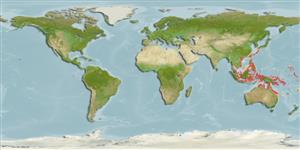Environment: milieu / climate zone / depth range / distribution range
Ecologia
marinhas associadas(os) a recifes; intervalo de profundidade 1 - 10 m (Ref. 48636). Tropical
Western Central Pacific: Philippines, Indonesia (Ref. 393) and Papua New Guinea (Ref. 6192) also reported from Heron Island (Brian Mayes, pers. comm., brian@mayescai.freeserve.co.uk).
Tamanho / Peso / Idade
Maturity: Lm ? range ? - ? cm
Max length : 15.0 cm TL macho/indeterminado; (Ref. 393)
Descrição suscinta
Chaves de identificação | Morfologia | Morfometria
Series of dark blotches along the body. The most darkened chest and belly distinguishes this species from the similar Salarias fasciatus. In addition, S. ceramensis has 15 pectoral fin rays, S. fasciatus only has 14 (Ref. 48636).
Facultative air-breathing (Ref. 126274); Adults occur solitary on dead corals (Ref. 90102) in sheltered bays and lagoons, often silty habitat, amongst mixed algae and coral rubble to about 10 m depth (Ref. 48636). Oviparous. Eggs are demersal and adhesive (Ref. 205), and are attached to the substrate via a filamentous, adhesive pad or pedestal (Ref. 94114). Larvae are planktonic, often found in shallow, coastal waters (Ref. 94114). Minimum depth of 1 m reported from Ref. 90102.
Ciclo de vida ou comportamento de acasalamento
Maturidade | Reprodução | Desova | Ovos | Fecundidade | Larvas
Oviparous, distinct pairing (Ref. 205).
Rau, N. and A. Rau, 1980. Commercial marine fishes of the Central Philippines (bony fish). German Agency for Technical Cooperation, Germany. 623 pp. (Ref. 393)
Status na Lista Vermelha da UICN (Ref. 130435: Version 2024-2)
Ameaça para os humanos
Harmless
Uso pelos humanos
Pescarias: pouco comercial; Aquário: Espécies comerciais
Ferramentas
Relatórios especiais
Baixar XML
Fontes da internet
Estimates based on models
Preferred temperature (Ref.
123201): 26.8 - 29.3, mean 28.8 °C (based on 1595 cells).
Índice de diversidade filogenética (Ref.
82804): PD
50 = 0.5001 [Uniqueness, from 0.5 = low to 2.0 = high].
Bayesian length-weight: a=0.00776 (0.00356 - 0.01695), b=3.00 (2.81 - 3.19), in cm total length, based on LWR estimates for this (Sub)family-body shape (Ref.
93245).
Nível Trófico (Ref.
69278): 2.0 ±0.00 se; based on food items.
Resiliência (Ref.
120179): Elevada, tempo mínimo de duplicação da população menor que 15 meses (Preliminary K or Fecundity.).
Fishing Vulnerability (Ref.
59153): Low vulnerability (10 of 100).
Nutrients (Ref.
124155): Calcium = 119 [58, 205] mg/100g; Iron = 0.749 [0.423, 1.314] mg/100g; Protein = 18 [17, 19] %; Omega3 = 0.0741 [, ] g/100g; Selenium = 23 [11, 52] μg/100g; VitaminA = 101 [25, 409] μg/100g; Zinc = 2.32 [1.53, 3.38] mg/100g (wet weight);
